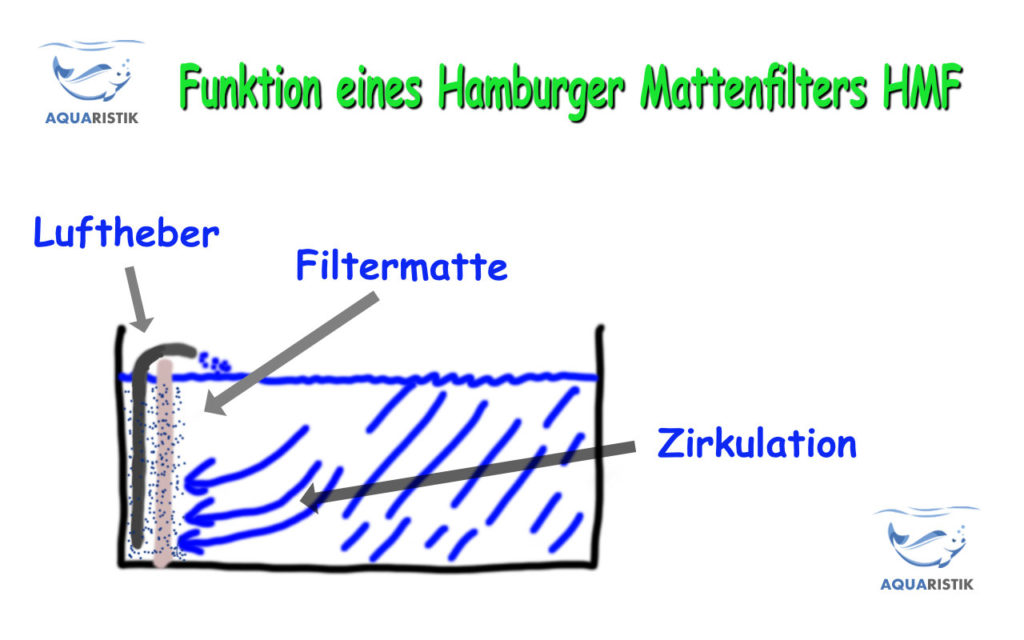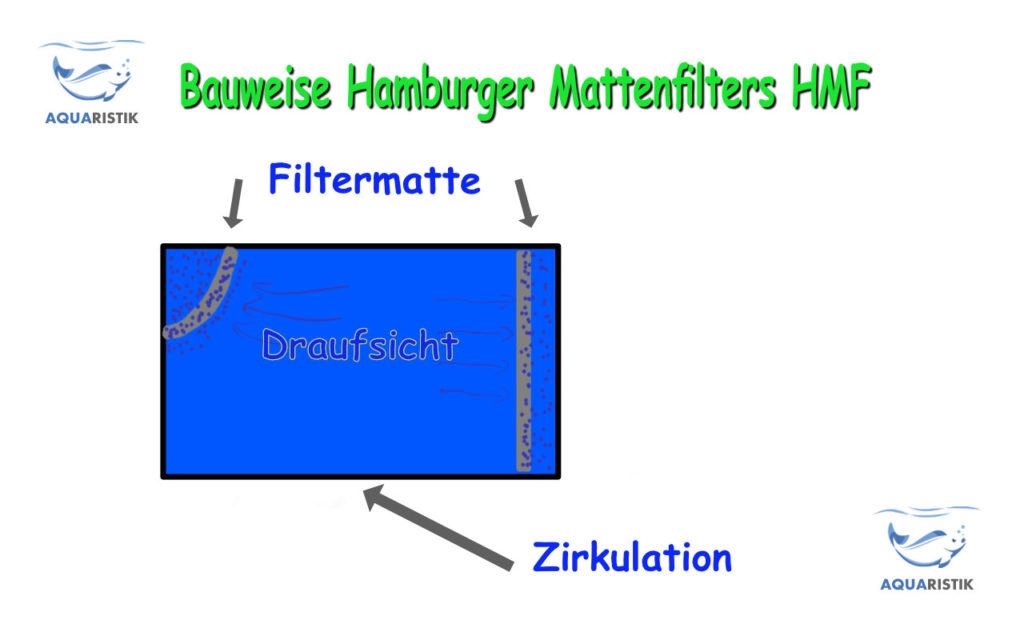Table of Contents
Where does the name Hamburg mat filter come from?
Surely you have already asked yourself why the mat filter has the nickname Hamburg mat filter. We also asked ourselves this question and were not really successful in our research. It is currently assumed that this filter was propagated by a well-known Hamburg aquarist. Thus, the addition Hamburger mat filter has become common.
The basic function of a filter
Most aquariums, one can certainly assume 95 percent here, have a filter. Filtering is an essential part around the nitrification and thus also the enrichment of the bacteria to make sure. Bacteria need one fertile soil and you will find this, among other things, on the filter media (filter sponges, filter floss, filter mats). Of course also serves mulm and other areas of the aquarium as a bacteria collection point, so that even with a filter-free aquarium you can have a filter effect has. As a rule, however, help is given here, because the purpose of an aquarium filter goes one step further. It should also filter and remove suspended matter and soluble impurities in the aquarium water.
Finally, a word about nitrification or nitrogen cycle. This process is carried out by the so-called Nitrobacer bacteria stimulated and only made to run. Nitrobacer arise in the sludge but also in the biological filter of an aquarium. They are responsible for converting toxic nitrite into non-toxic nitrate. This nitrate in turn serves as food for the plants.
We have more about the nitrogen cycle in our article on the nitrite peak for your convenience.
There you will also find a corresponding infographic, which also illustrates this process.
So let's summarize: Filtering is very important in the aquarium and even without a mechanical filter there is biological filtering by the bacteria living in the sludge. That's why it's always important to have a certain number to have from Mulm in the basin.
So let's summarize what a filter is and what purpose it serves. Above all, it should serve as a breeding ground for the bacteria Nitrobacter, which in turn are needed to convert and eliminate toxic substances (nitrite). In addition, it naturally ensures the removal of suspended matter. But that's enough about the general function and mode of operation of a filter, after all we want to take care of the HMF.
What is a Hamburg mat filter anyway?
But now we come specifically to the Hamburg mat filter and what makes it so special. Basically you have to get rid of the idea of putting the filter in a separate housing, as is the case with the external and internal filters of the brands Eheim, Tetra, Sera or JBL. Here the filter medium is placed directly in the aquarium and there is no housing around it.
The placement usually extends across the width of the aquarium. In addition, there is also the type of assembly that the filter sponge is mounted over the corner with the help of strips.
Basically, the Hamburg mat filter is a filter sponge that has a different filter effect depending on its thickness and strength or width. Of course, that also plays a part perforation a role. There are different ones here pore sizes, what a PPI be specified. Of course, this PPI number is also decisive for the inflow speed or the flow rate, although other factors are also decisive here. But more on that later.
This filter mat or often also called filter sponge is usually made of polyurethane and is therefore quite easy to cut and of course to wash out.
According to different opinions, it doesn't matter that much how you choose the PPI value. It should be matched to the size of the fish. In the shrimp tank you will certainly use other PPI values than in a perch tank, for example
This filter mat is basically just cut to fit and stretched across the width of the pool. Behind it there is about 5 cm of air or water.
In this area comes the air lifter or Czech air lifter, which sucks in the water and releases it again at the top. We have also attached a sketch, which should quickly show what the whole thing looks like.
Basically it was already with the construction.

Which components are required for a Hamburg mat filter?
Now we come to the required components of the Hamburg mat filter. Only a few components are required here. On the one hand you need the appropriate filter mat with the necessary PPI number and size. Then a Czech or regular air jack is needed. We have written a separate article about the exact functional principle of this and how you can build it yourself.
Then a membrane pump or air pump with the necessary performance is required. This is connected to the lifter with the help of a hose and the HMF is ready.
What is needed?
- Filter mat / filter medium in the right size and PPI number
- Correct size air jack
- Silicone hose for connection to the compressor
- Air pump / diaphragm pump
- Possibly glue and plastic rails / brackets for corner mounting
The exact design of an HMF and the required pump capacity
Basically, the components and the functional principle are quite simple. It gets a little more complicated with the interpretation like a Hamburg mat filter. Various factors that have a decisive influence on the filter behavior must be taken into account here. These factors are explained in more detail as follows.
In particular, the following must be observed:
- Approach velocity
- Pump performance
- Cross section of the HMF
What is the face velocity?
Let's start with the Approach velocity of the HMF. You often read words like that here Flow rate or the flow rate. Basically, it's about how much water runs through the filter and of course how fast.
The effectiveness of the filter is decisively influenced by the dwell time of the water in the filter. Depending on how quickly the water is "pulled through" here, the fewer or more bacteria can settle. In the worst case, the bacteria would be flushed out and the benefit would be lost.
The flow velocity is therefore extremely important. The flow of water to the filter medium can be calculated accordingly. The calculations can be found in the linked button.
The calculation is carried out using the area of the filter medium in cm² (length x width lxw) and the flow rate of the pump in liters per hour (usually indicated on the pump). Then you come to the inflow factor with the unit cm per minute.
From approx. 30 cm/min it is assumed that the bacteria are flushed through. Thus, no bacterial lawn would be able to accumulate. That's why you should pay attention to this number.
| # | Preview | Products | Rating | Price | |
|---|---|---|---|---|---|
| 1 |  | Tetra APS 100 aquarium air pump - quiet membrane pump for aquariums from 50-100 L, black | 12,09 EUR | View product | |
| 2 |  | FEDOUR 3W quiet aquarium air pump, 300L / H oxygen pump powerful aerator for aquariums ... | 16,97 EUR | View product | |
| 3 |  | Eheim 3702010 air pump air pump adjustable | 35,95 EUR | View product |
Cross section and pump performance of the HMF
As already mentioned for the inflow velocity, another factor is the Pump performance, because of course the inflow speed depends on it. But if you want to calculate the pump performance, then you basically only have to start with the optimal inflow velocity. Here are very often mean values of 7,5 cm/min is assumed and with the help of this the pump capacity in liters per hour is calculated. The pump can be designed accordingly based on this value.
Of course, the surface of the filter medium is also required here. This is usually fixed and depends on the dimensions of the aquarium. Of course, the circulation per hour must also be taken into account in the calculation. A 1-fold or 2-fold circulation is usually assumed here. Here, too, we recommend starting with a middle ground and would assume 1,5 times per hour. Then the water of the aquarium would flow through the filter mat 1,5 times in one hour.
Another factor that can also influence the pump performance and, above all, the effectiveness is the Thickness or the cross-section of the filter medium. There are a few things to keep in mind here too. The retention time of the water also depends on the thickness of the filter mat. According to our research, optimal values of 5 cm thickness are assumed here. The mat should not be made thicker. However, whether it is only 4 cm does not play a role in the filter performance.
Assembly and construction of the Hamburg mat filter
We have already described the structure of the HMF above. Now we want to say a few words about assembly, because this usually requires fewer steps.
If you cut the filter mat to size, then you should make sure that it is slightly larger than the dimensions of the pool, because then it stretches all by itself and further bonding is normally not necessary. In the case of corner mounting, a plastic rail must of course be glued, otherwise the filter would slip too easily. Here it is advisable to simply buy plastic angles or profiles from the hardware store and then glue them in with aquarium silicone.

The air lifter is simply placed behind it and usually does not require any attachment. The outlet comes back into the pool above the filter mat. Of course, you can also attach the air lifter with appropriate suction cups so that it does not slip. Then only the silicone hose has to be connected accordingly and the HMF is ready and can be put into operation. We have also linked a corresponding video.
Of course there are still many variations of an HMF. It can be done in a mobile way by enclosing the air lifter with the filter mat, or by installing the appropriate housing. But the basic form is nicely shown below.
Doesn't the Hamburg mat filter take up too much space?
In conclusion, however, we would like to come to a topic that is often addressed, because critics are always loud that the HMF ultimately takes up valuable space in the aquarium. From a biological point of view, however, this is not a lost place, but a well spent one. The amount of mulm thus increases, as does the breeding ground for bacteria. This is a much better environment for your ornamental fish or shrimp.
Of course, a Hamburg mat filter can be built to save space on the one hand by building it around the corner, especially in small aquariums. Of course, the reduction in the filter area and thus the change in pump performance and inflow speed should also be taken into account. In addition, an HMF can also be installed in a separate filter tank. This usually happens in very large aquariums.
The many reports and positive opinions about the HMF show that the Hamburg mat filter is very popular with aquarists.
[the_ad id = “1019 ″]








